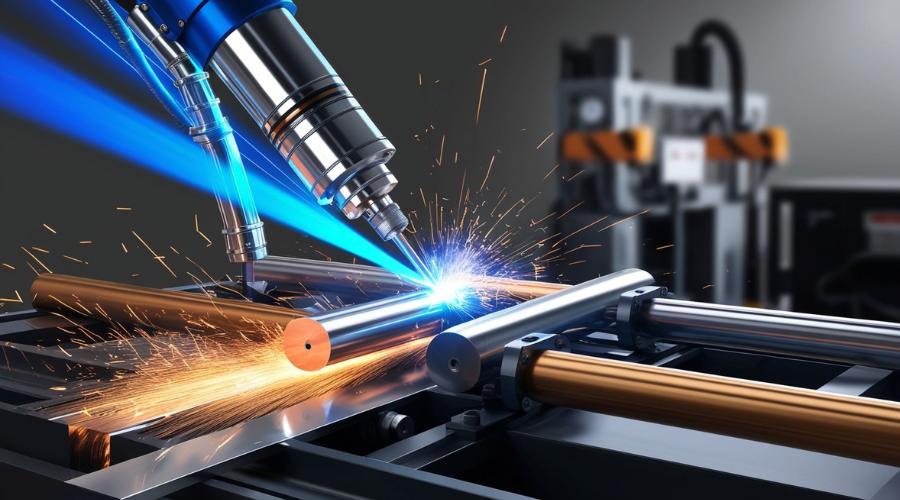.jpg)
Blogs
Laser Welding 101: A Beginner's Guide to the Technology

Many people wonder how car parts and medical devices get their precise connections and discover that laser welding is a crucial technology. Laser welding is a thoroughly developed industrial process that operates in numerous modern production sectors.
What Exactly is Laser Welding?
A laser beam creates the basis for welding two materials together. A laser generates a heat concentration that vaporizes material around the joint area as the welded pieces combine during cooling.
A laser is a highly accurate and powerful light tool that melts plastic and metal materials at their designated spot. The process delivers quick results with high accuracy and maintains a clean operation.
How Laser Welding Works?
The procedure of laser welding functions by applying a rugged laser beam toward the location where two parts need to connect. A computer system enables precise control of this beam, ensuring excellent operations accuracy. The typical procedures operate as follows:
- The two welding components remain near each other.
- The laser beam generates powerful heat when focusing on the seam area.
- The materials experience melting during the moment of contact.
- When the laser beam shifts or stops emitting heat, the melted section returns to solid form while cooling down.
- The two parts have become one unified structure through the procedure.
Different Types of Laser Welding
Among various laser welding types, the primary ones used are:
Conduction welding:
Laser welding through conduction involves heating only the outer layer of metal materials. The heating process of a stove pan spreads its heat evenly throughout the metal material. The welding process produces neat and smooth results for thin materials.
Keyhole welding:
During keyhole welding operations, the laser power is high enough to generate a hole through the metal. The hot metal vapor enters through the "keyhole" opening, enabling the laser beam to penetrate deeper into the material.
The laser path triggers molten metal to follow behind until it solidifies. The welding process provides excellent outcomes on thicker materials and generates extremely robust welds.
Laser Welding Benefits
Laser welding has several benefits which give it an edge over traditional welding:
1. High Precision
Laser welding works exceptionally well to join delicate or miniature components. A laser beam delivers precise heat to narrow spots, leaving the adjacent material unharmed.
2. Fast Process
Laser welding is quick. The process completes material fusion at a faster rate than standard welding techniques, which enhances production speed.
3. Clean Welds
Laser welding produces minimal smoke and spatter, thus resulting in easy cleanup and better final appearance.
4. Less Heat Damage
The laser produces a narrow beam that prevents heat from affecting extensive areas. Nearby components stay protected from damage because of this method.
5. Automated Friendly
Laser welding operates smoothly with robotic systems and machine-based automation. Manufacturers who need repetitive welding operations benefit substantially from this method.
Common Applications of Laser Welding
Laser welding operates beyond high-tech laboratories because multiple industries with unexpected applications utilize this technology.
- Car manufacturing: Laser welding techniques make the sophisticated shapes of automobile bodies possible. Many are laser welded. Laser welding is popular with automakers because it is strong, accurate, and machine-operated.
- Medical devices: The welding of medical devices requires perfect connections without contamination affecting surgical tools or pacemakers. The welds produced by laser technology work exceptionally well with delicate materials.
- Jewelry making: Laser welding serves jewelry making by repairing and connecting delicate jewelry components that traditional welding heat would damage.
- Electronics: Your mobile phone and computer contain electronic components combined with laser welding techniques. Laser welding is the sole choice for joining small parts that measure below the size of a grain of rice.
- Aerospace: Laser welding technology makes it possible to join airplane parts in a way that is both strong and safe for people.
Challenges of Laser Welding
Laser welding faces challenges similar to other technologies, which makes it unsuitable for all applications:
- Purchasing and keeping laser welding machines requires significant financial investment. The cost of acquiring a quality laser welding system ranges from tens to hundreds of thousands.
- Safety Needs Demand attention due to laser power capabilities that melt metals, which makes them Dangerous to People. The execution of special safety measures and training constitutes an essential requirement.
- The laser welding process excels with various metal types but encounters difficulties working with copper because the laser beam reflects from shiny surfaces instead of getting absorbed.
- Proficient technical expertise is required to establish an excellent laser weld because it demands an understanding of materials and laser equipment. Welding requires more than basic knowledge of holding a welding torch to begin.
The Future of Laser Welding
Laser welding technology keeps improving. New developments include:
- Fiber Lasers: Fiber Lasers establish themselves as more efficient and reliable laser types, which reduces barriers to technological accessibility.
- Hybrid Systems: Modern welding operations integrate laser technology with conventional systems to leverage their advantages.
- More innovative Controls: Advanced sensors and algorithms automatically change laser power and speed to provide the best results, allowing real-time weld monitoring.
Final Words
Laser welding operates by applying intense light beams to create metal welds despite their initial complex appearance. This technology has become highly sought after in various industries because of its precise nature, strong performance, and clean joining capabilities.
Knowledge about laser welding technology enables potential users to discover its potential for creating strong, precise metal joints in their projects. Due to decreasing costs and improved equipment usability, laser welding technology will expand into additional uses.
FAQs
1. What is laser welding, and how does it work?
Laser welding is a precise and high-speed welding process that uses a focused laser beam to melt and join materials, usually metals. The intense heat from the laser creates a small, deep weld pool, allowing for strong and clean joints with minimal distortion.
2. What materials can be welded using laser welding?
Laser welding is well-suited for a variety of metals, including stainless steel, carbon steel, aluminum, titanium, and even dissimilar metal combinations. It’s commonly used in industries like automotive, aerospace, medical devices, and electronics.
3. What are the advantages of laser welding over traditional welding methods?
Laser welding offers several benefits:
- High precision and control
- Minimal heat-affected zone
- Faster processing speeds
- Cleaner and stronger welds
- Less post-processing or cleanup required
4. Is laser welding suitable for beginners or DIY projects?
While laser welding is highly efficient, it requires specialized equipment and safety precautions. It’s not typically recommended for beginners or casual DIY enthusiasts unless they’ve received proper training and have access to the right tools.
5. What safety precautions should be taken when laser welding?
Laser welding can be hazardous without proper protection. Operators should use appropriate eye protection, wear protective clothing, and ensure the workspace is equipped with laser safety barriers and ventilation systems to avoid exposure to laser radiation and fumes.
